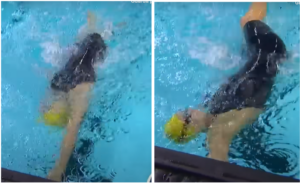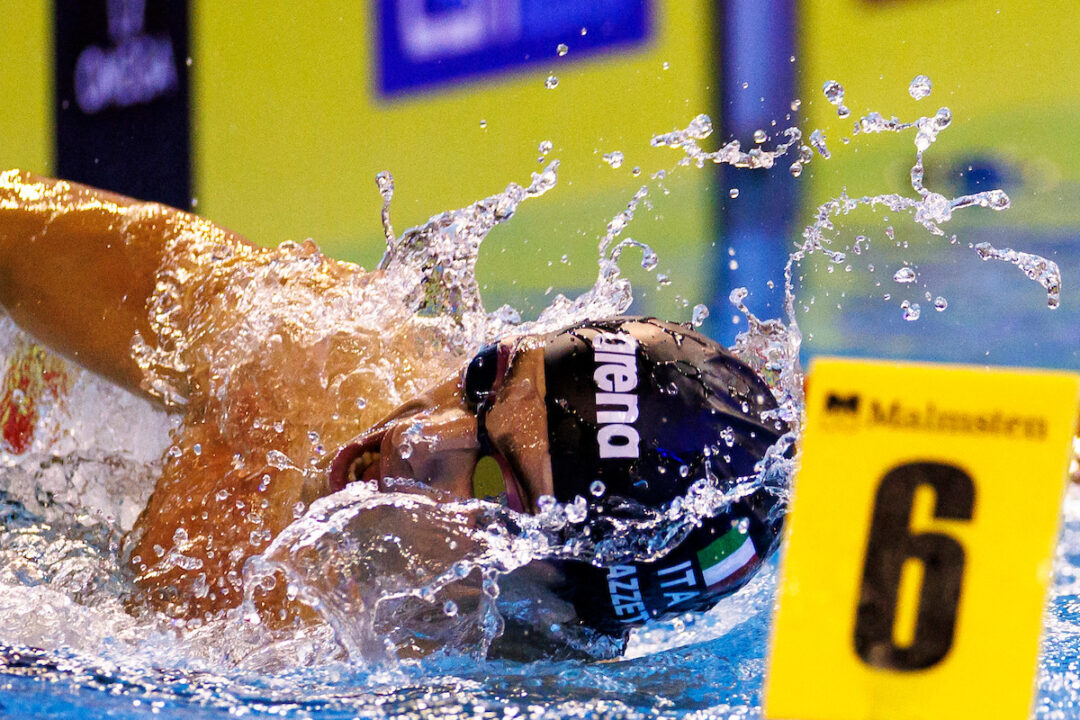“For the next meet, I signed you up for the 200 IM.”
When your coach says these words, there’s always that extra shiver running down your spine.
After all, it’s not technically the toughest race on the program. There are worse ones, just saying.
Yet, one of the biggest fears for any swimmer—from the youngest age group swimmer all the way to an Olympic champion—comes from the IM: the back-to-breast turn.
Maybe only the fear of losing count of the laps in a 400 or 800 freestyle (not as rare as you’d think) can compete.
Despite this, the relentless drive to push limits has led swimmers to adopt always more complex turns, all in the pursuit of a smoother, more efficient transition.
Back-to-Breast Turns
Open Turn, “Touch and Go”: This is the classic turn, the first one we learn, and up until the early 2010s, it was still the most common turn even among Olympians. It involves touching the wall on your back, then initiating a turn similar to a breaststroke or butterfly one. After the touch, the head lifts as the legs tuck toward the chest, and once both feet are on the wall, the finishing hand swings out of the water to start the push-off and breaststroke leg.
- Pros: Very simple, allows for a quick breath just before the underwater phase.
- Cons: The movement isn’t fluid, and lifting the head makes it a slower option.
Somersault Turn: Also known as the “suicide turn”, this technique gained popularity in the second half of the last decade. It starts with a backstroke finish, followed by a backward flip, where the swimmer flips head-down, fully facing the wall.
- Pros: Smooth and fast.
- Cons: It’s called the suicide turn for a reason, with the backstroke glide into the wall and the reverse flip, it burns much more oxygen than a regular forward flip. Swimmers often find themselves launching into a breaststroke pullout at the speed of light just to get back up for air.
Crossover Turn: The newest and currently most widely used back-to-breast transition. The crossover turn begins with a backstroke finish, followed by submerging the head and rotating toward the opposite side of the finishing arm. The legs then tuck into a side-flip motion before completing the push-off.
- Pros: The fastest, most elegant, and visually impressive turn. It’s also far less oxygen-demanding than the suicide turn, despite the lack of a head lift.
- Cons: It’s difficult to master since rotating toward the opposite side of the finishing arm feels counterintuitive. Additionally, timing the stroke correctly is tricky as misplacing the hand on the wall can lead to an inefficient, often crooked push-off (See the case of the Polish swimmer who ended up in a different lane).
How Do Olympians Turn?
The crossover turn has become the favorite among Olympic athletes, who prioritize its pros over its cons.
It’s interesting to note that just a few years ago, up until competitions held between 2022 and 2023, there was a greater variety in turn choices. Now, however, opting for the crossover turn seems like an unwritten rule for elite medley swimmers.
For example, Canadian champion Summer McIntosh swam the 400 IM at the 2023 World Championships in Fukuoka, where she claimed the gold medal, using the classic open turn, while most of her competitors preferred the crossover. It was likely a strategic choice, proving that in a 400 IM, the risk of making a mistake outweighed the efficiency gain.
However, over the past year, the 18-year-old talent has adapted to the evolution of this event, becoming one of the best examples to study for mastering this technique.
McIntosh, along with another standout athlete, Thomas Ceccon, approaches the turn differently from most swimmers. When learning this movement, a common method is to start by practicing the finish on the side (opposite to the arm touching the wall). While this helps speed up the learning process, it often introduces errors that are hard to eliminate in competition. One major risk is touching the wall not in a lateral position—at an angle of less than 90°—but already face down.

Summer McIntosh at the 2024 Canadian Trials, where she set the world record in the 400 IM (CBC Sports)
It’s important to remember that World Aquatics regulations state that:
(SW 9.4) Each section must be finished in accordance with the rule which applies to the stroke concerned.
The backstroke leg must therefore finish in a supine position, and any deviation from this rule is considered an infraction, leading to disqualification.
The side finish can also be seen in the turns of multiple-time world champion and IM specialist Leon Marchand, as well as Olympic medalists in the 200 IM—Alex Walsh (silver in Tokyo), and Kaylee McKeown (bronze in Paris).

Kaylee McKeown (left) and Alex Walsh (right) at Fukuoka 2023 Worlds
The Risk of Disqualification and Controversies
These two athletes indeed have often been at the center of controversial cases due to this technical inaccuracy.
2023 World Championships in Fukuoka
During the 200 IM semifinals at the World Championships, both were involved in an ambiguous disqualification/non-disqualification case. As seen in the images above, Kaylee McKeown prematurely turns her gaze toward the wall, almost forgetting that she had to go for a back-to-breast transition and initiate the back-to-back turn. However, the footage clearly shows that she does not continue rotating and illegally touches the wall on her side.
In the adjacent lane, her rival Alex Walsh appears to reach the wall with her stomach facing the bottom of the pool before making contact with the wall.
Judges ultimately decided to disqualify the Australian, along with Italy’s Sara Franceschi and Great Britain’s Katie Shanahan. No action was taken against the American swimmer.
2024 Paris Olympics
Karma, however, can be cruel. During the same event at the Paris Olympics, Alex Walsh was disqualified after initially winning the bronze medal, due to the very same mistake that had secured her a podium finish in Fukuoka. Who “benefited” from this disqualification? None other than two-time Olympic backstroke champion Kaylee McKeown, who moved from fourth place to the Olympic podium.
Changing the Rules?
In the history of swimming, it’s not uncommon for rules to change as the sport evolves and ambiguities in interpretation increase. Until 1991, in the back-to-back turn, swimmers were required to touch the wall with their hand before flipping, essentially performing a crossover turn. However, due to the increasing difficulty of recognizing infractions, the rule was changed to allow a freestyle stroke before executing the forward flip.
Another case is the dolphin kick in the breaststroke underwater: when it became too difficult to consistently identify violations, officials opted to legalize the movement.
Could the same thing happen for the back-to-breast turn?
There are several criticisms of this proposal:
- One of the defining features of the IM is the presence of real transitions, different from standard turns. It would be like removing transitions in triathlon, turning it into a mere combination of swimming, cycling, and running (fly, back, breast and free), whereas transitions are a key factor that makes the event unique.
- It would also reduce the entertainment value and intrigue: it’s fascinating to watch how different athletes handle this extra element and how each can gain an advantage from it.
What’s your thought about it?

Love the article nice history and great way to talk about evolution in the sport.
I still hate that picture from 2023 Worlds. Alex touched in 1:00.12 her hand is already on the wall in that pic with her wrist bending. Kaylee touched at 1:00.49, .37 behind and hasn’t touched the wall yet in the picture. That picture tells us about Alex’s body position after she touched and shows Kaylee in a legal position before she touched. Both could have been legal, both could have been illegal, but that picture doesn’t really tell us. I know it’s the best we have, but I still hate it. (source: https://www.worldaquatics.com/competitions/1/world-aquatics-championships-fukuoka-2023/results?disciplines=&event=ac8148dc-4336-43c6-ba8a-e0674d62148c&unit=semifinals-summary since they still show the splits… Read more »
From the 2023 swimswam article (and from watching the videos), Walsh’s turn was even more suspect than McKeown’s. You’d think Walsh would have taken note. Same with Ress in 2022. You’d think he would have learnt when he was underwater in heats and semis. Oh well.
Your comment seems to suggest you think that’s one picture taken at one moment. It’s two different pictures and they’re not taken at the exact same millisecond.
Walsh very obviously is all the way on her stomach well before she touched. Much more egregious than McKeown but let go.
Maybe if the rules had been applied properly to Walsh in 2023 she wouldn’t have lost a medal in Paris.
Point still stands. Alex’s hand is on the wall and Kaylee’s is not. Your are right that I brain fogged and thought it was a single photo. (Long COVID sucks and it was nearly 2 years ago). But they have presented that image several times and it’s still pointless for both. I do recall thinking both should have been DQ’d like I said. I’m not defending either side. That image is but good for either point though.
Thank you for not letting my mistake slide by, that’s not sarcasm. I say something dumb like I did and it doesn’t help my overall argument.
Nice article
I feel like all of these turns were around on the 80s. More swimmers use the exotic ones now though.
Hosszu had the best crossover turn I’ve seen – always so crisp and fast